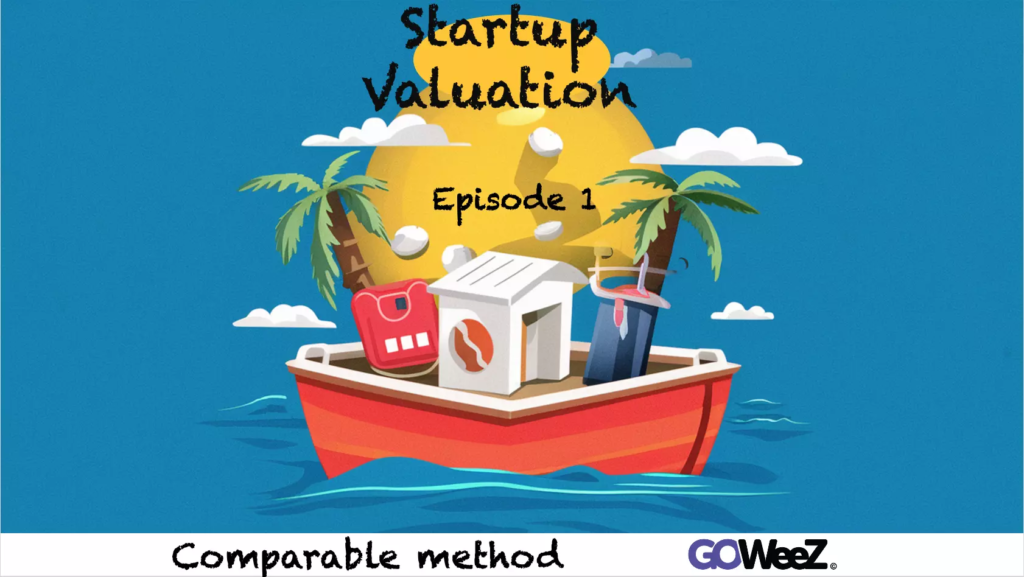The global EdTech market is experiencing unprecedented growth. It is expected to reach nearly $404 billion by the end of 2025, with an annual growth rate of over 16%. This
GOWeeZ will help you review your calculation methods for valuing your start-up.
There are different principles for valuing start-ups, which are identified and used according to a number of points.
Valuing a start-up is a crucial stage in your strategic development.
It enables you to determine its market value for investors. There are several methods for valuing a start-up, each with its own specific features and advantages.
This article explores the comparables method and provides examples of calculations to illustrate the valuation process more clearly.

The comparables method involves valuing a start-up by comparing its characteristics with those of similar companies that have recently been traded.
Simply put, if a technology start-up has annual sales of €1 million and similar companies have sold for a multiple of 5 times.
But it’s not that simple…
This method requires you to find comparable companies and recent transaction data.
This calculation can often be based on companies with SaaS business models in a specific sector.
In fact, a software publishing start-up could compare its financial metrics with companies such as SaaS companies.
Obviously, factors such as size and market segment need to be adjusted.
The use of the comparable method involves the following metrics in the calculation
Price/Earnings (P/E), Price/Sales (P/S) et Enterprise Value/Revenue (EV/Revenue) or Enterprise Value/Ebitda.
Then apply the derived multiples to the startup’s metrics to estimate its valuation.
This method is particularly useful because of its dependence on actual market data. It provides a realistic, market-aligned valuation.
However, it requires careful selection of truly comparable companies to ensure the accuracy and relevance of the valuation process.
Enterprise Value (EV) is calculated by adding debt to market capitalisation. Minority interests and preference shares, and then subtracting total available cash or cash equivalents.
EBITDA, which stands for earnings before interest, tax, depreciation and amortisation, is a key measure because it excludes the effects of tax and financial expenses, thus providing a clearer view of the company’s operating performance.

The business multiple is particularly useful for comparing the real value of companies.
It eliminates the distortions caused by tax differences on profits.
This multiple is commonly used when evaluating potential acquisitions, as it takes into account the debt that the acquirer will have to assume if it buys the company.
The business multiple is therefore often considered a more reliable indicator than market capitalisation alone.
A low business multiple may indicate an attractive acquisition opportunity. Comparisons of business multiples between different companies are more accurate when made within the same industry.
Therefore, companies share similar characteristics.
In addition, this multiple varies according to the maturity and growth rate of the company.
High-growth companies tend to have higher business multiples than slower-growth companies, reflecting their potential for higher future earnings.
NB
Let’s assume a fictitious company called “Tech Innovation Inc. any similarity with an existing company would be purely coincidental.
Here is the financial data needed to perform the calculation:
Calculation of enterprise value (EV):
EV= Market capitalisation + Debt + Minority interests and preference shares – Cash and cash equivalents
EV= 50,000,000 + 20,000,000 + 5,000,000 – 10,000,000 = €65,000,000
The company’s multiple is therefore calculated as 65,000,000 / 15,000,000 = 4 .33
At GOWeeZ, We work with investors such as family offices who are interested in innovative growth projects.
If you would like to present your project :
Apply on MY PITCH IS GOOD
or directly on GOWEEZ on Venture Page
Other articles on investment and entrepreneurship that might interest you:
Advisor et Consultant auprès des dirigeants d'entreprise - Président de GOWeeZ. et fondateur de MY PITCH IS GOOD !
La gestion des risques est devenue un challenge à suivre pour tous les dirigeants de toutes tailles d'entreprise. GOWeeZ vous présente sans cet article une société qui depuis 10 ans accompagne plus de 2500 clients dans ces actions réglementaires. Aléa Prévention offre une solution Cloud avec un accompagnement des entreprises avec un réseau d'IPRP. On vous explique l'offre de valeur d'Aléa Prévention
Fabrice Clément Tweet